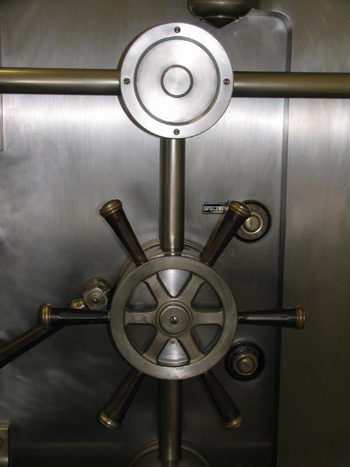 The Treasurer's main vault is an eye-catching and fascinating aspect of the West Virginia State Capitol that was installed four years after the construction of the building. Since the Treasurer is responsible for holding various securities and monies, officials felt an in-house vault was a necessity in the wake of that era's growing crime rate. The resulting fixture is a massive vault built with solid chromium steel and concrete, surrounded by walls 22 inches thick. It once took two contractors two-and-a-half days to bore a small air hole through the outer wall of the vault as a safety measure. The huge, 16-ton door is controlled by three clocks which are set on a 15-hour rotation at the end of each working day and 63-hour rotation each weekend. Once the door has been closed and clocks activated, the vault cannot be opened until its clocks automatically release at the end of the rotation cycles.
The Treasurer's main vault is an eye-catching and fascinating aspect of the West Virginia State Capitol that was installed four years after the construction of the building. Since the Treasurer is responsible for holding various securities and monies, officials felt an in-house vault was a necessity in the wake of that era's growing crime rate. The resulting fixture is a massive vault built with solid chromium steel and concrete, surrounded by walls 22 inches thick. It once took two contractors two-and-a-half days to bore a small air hole through the outer wall of the vault as a safety measure. The huge, 16-ton door is controlled by three clocks which are set on a 15-hour rotation at the end of each working day and 63-hour rotation each weekend. Once the door has been closed and clocks activated, the vault cannot be opened until its clocks automatically release at the end of the rotation cycles.
Forty smaller vaults inside the main vault are assigned to individual state agencies. Each agency stores various items, most of which are stocks and bonds. In addition to the stocks and bonds protected there, the vault is also home to collections of diamonds and rare coins, stamps, and state historical documents owned by the Division of Culture and History.
Because the vault was installed in the 1930s, a period of rampant crime and bank robberies, Treasury officials installed a 12-foot solid steel and glass barrier in front of the vault. Tellers sat behind two-inch thick glass panels that rested below an iron grate charged with several thousand volts of electricity. Gun turrets were installed in the event of an armed robbery.
Today, the Treasurer's office is a sleek, modern, state-of-the-art operation. Equipped with powerful computers and sophisticated electronic money management technology, the West Virginia Treasury continues to move forward as it administers and protects the sound investment of our vast resources in the future of the Mountain State.